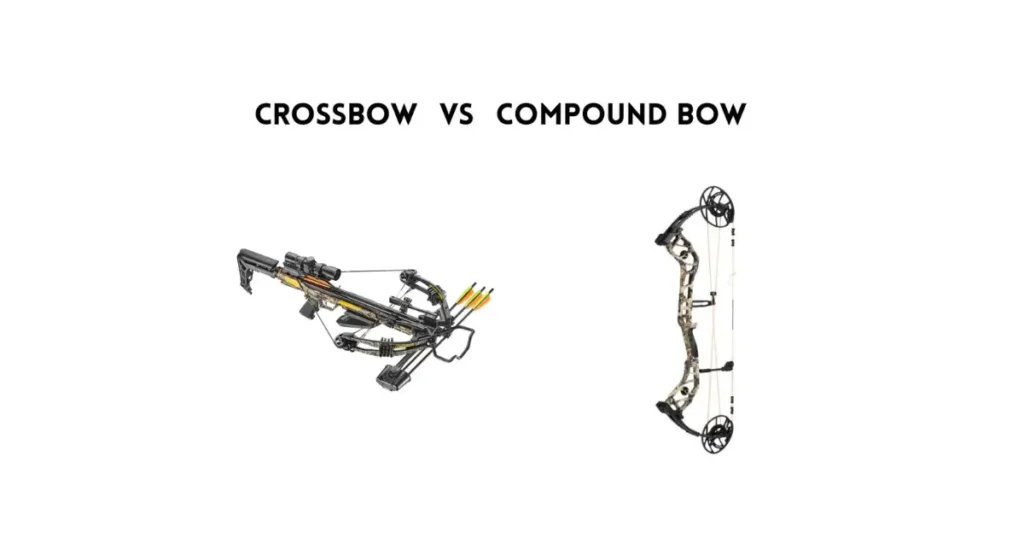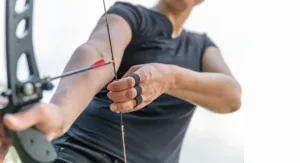In the world of archery and hunting, one debate stands tall -crossbows vs. compound bows. For hunters and archery enthusiasts alike, choosing the right bow is crucial, as it can significantly impact your hunting success and overall experience. This blog post dives deep into the intricacies of these two popular bows, offering valuable insights and tips to help you make an informed decision.
An Exploration Of The Past
Crossbows and compound bows have fascinating histories that shape their modern designs. Crossbows date back to ancient China, where they were pivotal in warfare due to their ease of use and power. Over the centuries, the design has evolved, becoming more compact and efficient, making them a favorite among hunters looking for precision and stealth.
On the other hand, compound bows are relatively novel, introduced in the 1960s. They revolutionized archery with their pulley and cable system, allowing more power and accuracy. This innovation makes compound bows a popular choice for those seeking a modern hunting tool that balances tradition with technological advancement.
Also Read : Discover The Art Of Crossbows And Their Many Uses
Comparison Of The Top Games

Accuracy
Crossbows and compound bows have their strengths in accuracy. Crossbows often provide enhanced precision at longer distances due to their stable platform and scope. This makes them ideal for hunters targeting game such as deer or elk in open fields.
Compound bows, however, excel in accuracy through customizable draw lengths and weights, allowing skilled archers to fine-tune their shot. With practice, compound bow users can achieve remarkable accuracy, even at challenging angles and varying distances.
Ease Of Use
An important factor for beginners is the ease of use. Crossbows are generally more user-friendly, especially for archery beginners. Their rifle-like design and scope make them intuitive for firearm enthusiasts. Testimonials from users often highlight how quickly they get comfortable with crossbows, reducing the learning curve.
Compound bows, while requiring more practice, offer rewarding experiences. The challenge of mastering a compound bow is part of its appeal, providing a sense of accomplishment as skills improve. For those dedicated to honing their craft, compound bows offer customization and engagement.
Power And Speed
In terms of power and speed, crossbows typically deliver higher kinetic energy, making them suitable for larger games. Their bolts travel faster and hit harder, ensuring a clean and ethical kill. However, compound bows are no slouches in this department. With advancements in technology, many compound bows now offer impressive speed and power, competing closely with crossbows.
Portability
When it comes to portability, compound bows have the upper hand. Their lightweight design makes them easier to carry over long distances, a significant advantage for hunters on the move. Crossbows, while more cumbersome, often come with shoulder straps or carrying cases to mitigate their bulkiness.
Maintenance
Maintenance is a key consideration for hunters. Compound bows require regular tuning and string adjustments, which can deter some. However, for dedicated archers, this maintenance routine becomes a cherished ritual, deepening their connection with their equipment.
Crossbows, while requiring less frequent tuning, still need care, especially keeping the strings and trigger mechanism in top condition. Understanding the maintenance needs of each bow type will ensure reliability in the field.
Also Read : Mastering The Art Of Stringing A Compound Bow
Comparison Table: Crossbow Vs. Compound Bow
| Feature | Crossbow | Compound Bow |
| Accuracy | Greater precision at longer distances, thanks to a stable platform and scope. | Customizable draw lengths and weights enhance accuracy for skilled archers. |
| Ease of Use | More user-friendly; intuitive design appeals to beginners. | Requires more practice but offers a rewarding learning experience. |
| Power and Speed | Typically delivers higher kinetic energy with faster bolts, ideal for larger game. | Offers impressive speed and power, competitive with crossbows, thanks to technological advancements. |
| Portability | Generally bulkier but some models come with carrying aids. | Lighter and easier to carry long distances, making it ideal for hunters on the move. |
| Maintenance | Requires less frequent tuning, but strings and trigger mechanisms need care. | Needs regular tuning and string adjustments, which some archers enjoy as part of their routine. |
Real-World Scenarios

Crossbow Triumph
Consider Steve, an experienced hunter who transitioned from compound bows to crossbows due to age-related physical limitations. His hunts in dense forests have been successful, thanks to the crossbow’s ease of use and accuracy in tight spaces. Steve’s story underscores the importance of selecting gear that complements your hunting environment.
Compound Bow Victory
In contrast, Emma, a skilled archer, found her compound bow the right tool for open plains hunting. Her ability to adjust the draw weight and length allowed her to adapt to varying game sizes, resulting in a high success rate. Emma’s example highlights how compound bows offer versatility in diverse hunting scenarios.
Also Read : Discover The Joy Of Archery With A Bow And Arrow For Beginners
The Cost Factor
Understanding the financial implications of your choice is essential. Crossbows often come with a higher upfront cost, particularly models equipped with advanced features. However, their lower maintenance requirements can save money over time.
Compound bows, while more affordable initially, may incur additional costs for accessories and regular tuning. Tools like Total Cost Calculators can help you determine which option aligns best with your budget and long-term goals.
Also Read : Mastering The Bow And Arrow: The Fun And Easy Guide For Beginners
Navigating The Legal Waters
Legal considerations play a crucial role in your decision-making process. Regulations surrounding crossbow and compound bow usage vary by region. Some areas have specific crossbow hunting seasons, while others restrict their use.
It is vital to consult local hunting regulations to ensure compliance. Websites like Hunter-Ed offer comprehensive resources for understanding the legal landscape in your area.
Also Read : Master Your Archery Game With A Deep Understanding Of Bow Parts
Pros And Cons Of Compound Bows And Crossbows
| Feature | Compound Bow | Crossbow |
| Pros | – Highly customizable for individual preferences – Offers a rewarding challenge for skill development – Generally lighter and easier to carry – Advanced technology contributes to speed and power | – User-friendly for beginners, intuitive design – Higher kinetic energy for larger game – Stable platform enhances accuracy at longer distances – Less frequent tuning required |
| Cons | – Requires regular maintenance and tuning – Steeper learning curve for beginners – May not be as powerful as crossbows for larger game | – Generally bulkier and heavier to carry – Higher upfront costs for advanced models – Less versatility in draw length adjustments |
Also Read : Mastering Archery Safety: Understanding Dry Firing A Bow
Voices From The Field
“Crossbows, with their compact size and ease of use, are excellent choices for hunters who prefer a more stealthy approach or have physical limitations. However, compound bows offer a certain finesse and challenge in hunting that can’t be replicated with a crossbow.”
According to Alex Johnson, Hunting Gear Expert.
“Accuracy and power are essential in hunting, and the choice between a crossbow and a compound bow ultimately depends on the hunter’s skill, hunting style, and the game being pursued. It’s not about one being better than the other, but rather which is better suited to the situation.”
As explained by Emily Archer, Wildlife Biologist and bowhunting enthusiast.
“I’ve seen the evolution of both bows over the years. While crossbows have become more efficient and user-friendly, compound bows still offer a level of customization and precision that some hunters can’t live without.”
Notes Michael Carter, Archery Instructor.
Also Read : How to Measure Draw Length of a Bow – Archery Guide
Final Thoughts
Ultimately, the choice between a crossbow and a compound bow boils down to personal preference, hunting style, and specific needs. Both options offer their own advantages and challenges, catering to different aspects of hunting.
By understanding the strengths and weaknesses of each bow type, you can make an informed decision that enhances your hunting adventures. Remember, the right bow feels like an extension of yourself, helping you connect with nature and succeed in the field.
Frequently Asked Questions (FAQs)
What Are The Key Differences Between A Crossbow And A Compound Bow?
The primary differences lie in design, ease of use, and application. Crossbows are more like rifles, offering a stable shooting platform and easier aiming. Compound bows provide customizable draw weights and lengths for precision shooting.
Which Is Better For Beginners: A Crossbow Or A Compound Bow?
Crossbows are typically beginner-friendly due to their straightforward operation. However, compound bows offer a rewarding learning curve for those willing to invest time in mastering archery.
Is A Crossbow More Accurate Than A Compound Bow?
Crossbows generally offer greater accuracy at longer distances due to their stable platform and scope. Compound bows, although requiring more skill, can achieve remarkable accuracy with practice.
What Is Easier To Maintain: A Crossbow Or A Compound Bow?
Crossbows need less frequent tuning, but they require attention to string and trigger maintenance. Compound bows require regular adjustments but foster a deeper connection with the gear for dedicated archers.
Can You Use A Crossbow During The Regular Archery Season?
Regulations vary by region, so consult local hunting laws. Some areas allow crossbows during specific seasons, while others restrict them.
What Is The Legal Status Of Crossbows Compared To Compound Bows?
Legal status varies by state and country. It’s essential to check with local authorities or visit websites like Hunter-Ed for comprehensive hunting regulations information.
In conclusion, weigh the pros and cons, consider your unique circumstances, and select the bow that aligns with your hunting goals. Whether you’re drawn to the precision of a crossbow or the finesse of a compound bow, both offer promise thrilling experiences in the wilderness outdoors.
References and Information Sources
- Hunter-Ed – A comprehensive resource for understanding hunting regulations and safety education.
- Archery Trade Association – Provides industry insights, education, and resources for archers and bowhunters.
- National Bowhunters’ Education Foundation – Offers educational programs and resources for safe and ethical bowhunting.
- Bowhunting.com – A platform dedicated to bowhunting news, tips, and product reviews.
- NRA Hunter Services – Offers information on hunting laws, shooting safety, and techniques.
- State Wildlife Agencies – Provides specific regulations and guidelines based on state for hunters and archers.
Recommended Articles
- Best Compound Bow For Women – A Comprehensive Buyer’s Guide
- A Comprehensive Guide To Pick Best Budget Crossbows
- The Ultimate Guide To Choosing And Maintaining The Perfect Bow And Arrow String
- Archery Injuries: Navigating The Path To Safety
- Unveiling the Intricacies: Anatomy of a Bow Decoded
- Discover The Power Of The Best Archery Stabilizer For Accuracy And Precision







